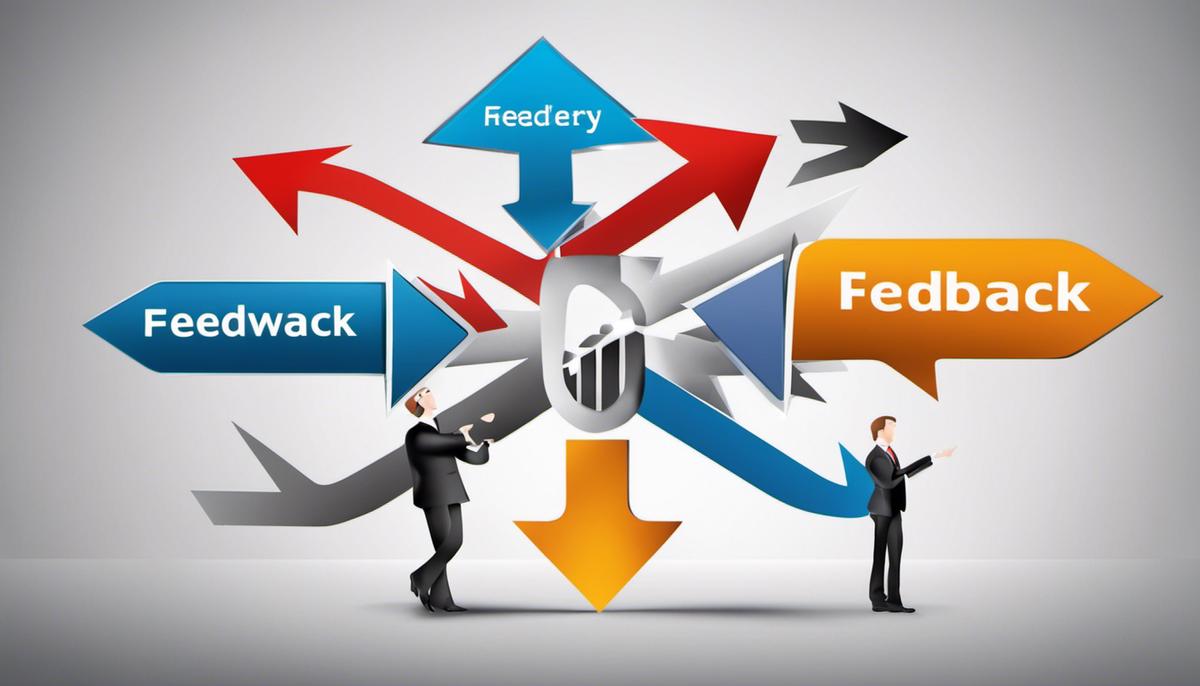Intensifying competition, accelerating change, and rising demands for talent underscore the importance of constructive feedback in leadership. Constructive feedback, when delivered effectively, serves as a catalyst for individual growth, team development, and organizational success. Encouraging a learning-centered environment, it shapes performance, kindles innovation, and promotes dynamic adaptivity crucial in today’s volatile business landscape. This exploration will unravel the criticality of constructive feedback in leadership, outlining key principles, essential skills, practical implementation guidelines, possible challenges, and methods to assess its impact.
The Importance of Constructive Feedback in Leadership
Understanding Constructive Feedback in Leadership
Constructive feedback, a core aspect of effective leadership, can be defined as a useful advice or comments that aim at improving the performance and behaviors of a team member. Leaders provide this feedback to their team members to help them foster growth, inspire change and drive improved performance. Constructive feedback focuses primarily on specific behaviors and actions, rather than the person, and it promotes a positive, forward-thinking approach.
The Impact of Constructive Feedback on Work Performance
Constructive feedback can significantly improve work performance in many ways. Feedback that is delivered clearly, timely, and constructively can address performance issues promptly, allowing employees to understand how they can improve and what expectations they need to meet. Constructive feedback can also help employees feel valued and understood, which may enhance their productivity and commitment to their job.
For leaders, providing such feedback also offers learning opportunities. They can identify areas for improvement, develop strategies to guide staff, and gain a better understanding of their team’s capabilities. Consequently, the result is a synergistic office environment that optimizes performance for both the leader and the team members.
The role of Constructive Feedback in Personal Growth and Innovation
The importance of constructive feedback also extends to personal growth and innovation. By offering insights into an individual’s strengths and weaknesses, feedback can spur personal and professional development. It may stimulate self-reflection, leading the individual to identify their areas of improvement, consequently motivating them to expand their skill set and knowledge.
Innovation, another crucial aspect of organizational growth, greatly benefits from constructive feedback. Feedback on ideas, proposals, and strategies can lead to more creative and effective solutions. It encourages open communication and collaboration, fosters a diverse and inclusive thinking environment, and promotes continual learning and problem solving.
Fostering a Learning Culture with Constructive Feedback
Constructive feedback also plays a pivotal role in fostering a culture of ongoing learning and development within the workplace. A consistent feedback process ensures that learning and improvement become integral components of an organization’s culture. Employees are encouraged to learn from their mistakes, enhance their skills, and strive for excellence. This kind of culture nurtures a collaborative environment, where knowledge is shared, and new ideas are appreciated.
Key Elements for Leadership Success
Powerful leaders are not only those who provide feedback, but also those who advocate for it. These individuals recognize that constructive criticism is invaluable in shaping a resilient team and fostering a favorable work culture. The open communication and trust that constructive feedback provides help in avoiding miscommunications and nurturing healthier relationships among the team. Furthermore, leaders who offer constructive feedback display emotional intelligence—an essential aspect of effective leadership. By emphasizing the importance of constructive feedback, leaders can facilitate notable improvements in team interactions, employee output, and the overall workplace atmosphere.

Understanding the Principles of Constructive Feedback
Grasping the Fundamentals of Constructive Feedback
Constructive feedback is a critical leadership instrument that significantly impacts both personal and professional growth within a team. It diverges from the common ‘top-down’ feedback style. Constructive feedback is instead fueled by dialogue, centering around positive reinforcement, understanding, and reciprocal improvement. For this to be effective, leaders must adhere to certain principles when providing feedback.
The Essentiality of Clarity in Feedback
Feedback should always be clear and concise, eschewing ambiguity or vagueness. This ensures that the feedback resonates with employees, fully communicating what they did well and what needs improving. Leaders should avoid using jargon or industry-specific language that may obscure the intended message. A successful feedback strategy involves open, clear communication that emphasizes mutual understanding.
The Importance of Specificity in Feedback
Being specific with feedback both acknowledges the accomplishments of team members and pinpoints areas for improvement. When the feedback is detailed and focused on particular aspects, it is easier for team members to understand the behaviors or actions that should be continued or changed. Leaders should highlight specific instances or examples when explaining the antecedent behaviors and their impact.
Timeliness: Delivering Feedback Right Away
To be effective, feedback should be given promptly. Delayed feedback may not have the intended impact as events and circumstances could have changed, making the feedback irrelevant. Timely feedback helps in rectifying any undesired behaviors immediately and reinforcing positive actions more effectively.
Solution-Oriented Feedback
Constructive feedback should always offer a path to improvement. By giving solutions and recommendations, leaders not only pinpoint areas that need work, but they also provide team members with actionable steps towards better performance. This solution-oriented approach encourages employees to embrace feedback, viewing it as an opportunity for growth rather than criticism.
Feedback as Part of Leadership Communication Strategy
Constructive feedback plays a significant role in the overall communication strategy of a successful leader. It is an ongoing process and should be practiced regularly to foster a continuous learning and improvement environment. Leaders who master the art of feedback demonstrate concern for their team’s growth, ensure team members feel valued, and directly influence the team’s overall performance and productivity. It is a key factor in building strong team relationships, increasing job satisfaction, improving performance, and effectively driving change.
Mastery of Feedback: Key to Effective Leadership
In every facet of leadership, the efficient use of feedback is indispensable. Be it acknowledging a team member’s accomplishments or identifying improvement areas, the core principles of providing precise, well-timed, solution-focused, and clear feedback directly influence the effectiveness of a leader. These elements are crucial in delivering truly constructive criticism.

Skills Required for Giving Constructive Feedback
Pivotal Skill: The Art of Active Listening
For leaders aiming at delivering constructive feedback, active listening is a vital skillset. This goes beyond merely hearing what an employee has to say. It involves understanding the full context of the message, noticing non-verbal cues like facial expressions, body language, and tone of voice, to fully comprehend a person’s point of view. By exhibiting active listening, a leader signals their sincere interest in the conversation, fostering a culture of honest communication and respect, which makes employees more open to feedback.
Consider this scenario – during a project discussion, a team member proposes an innovative approach. An actively listening leader will fully engage with this suggestion, displaying interest through actions such as maintaining eye contact or nodding in agreement. The leader must then summarize the idea, clarifying their understanding and tying up any loose ends, ensuring a thorough grasp of the proposed strategy.
Key Component: Empathy
Another key skill in providing constructive feedback is empathy. It entails understanding and sharing another person’s thoughts and experiences from their perspective. A leader can offer feedback more effectively when they take time to understand the feelings and motivations underlying an employee’s actions.
For instance, if an employee fails to meet a deadline due to workload from other tasks, an empathetic leader can address the missed deadline while acknowledging the employee’s task-overload situation. This approach shows that the leader considers all factors, reinforcing the feedback’s fairness and fostering a more understanding work environment.
Emotional Intelligence and Feedback
Emotional intelligence is integral in providing constructive feedback. It is the ability to identify, understand, and manage personal emotions and those of others. A high level of emotional intelligence enables leaders to deliver feedback in a manner that respects the individual’s emotions and fosters an environment of support and growth.
For example, if a leader needs to provide feedback on a staff member’s performance, being aware of their emotional response to the feedback helps to guide the conversation in a positive, constructive manner. Recognizing signs of defensiveness or frustration allows the leader to adjust their communication style or introduce reaffirming statements to ensure the employee remains open to the feedback.
Promoting Assertiveness in Delivering Feedback
An imperative skill in offering constructive feedback as a leader is assertiveness. To be assertive means expressing your viewpoints respectfully whilst also recognizing the perspectives of others. Leaders who embody assertiveness are able to deliver transparent, sincere feedback without appearing overbearing or dismissive.
Imagine a situation where a team member consistently interrupts during meetings. A leader exhibiting assertiveness would address this behavior in a respectful yet direct manner: “I’ve observed your tendency to interject during our meetings. While your enthusiasm is valued, it’s essential that every member gets an opportunity to share their ideas. Let’s collectively work on improving this.” The feedback here is precise, respectful and focused on the behavior rather than the individual. It also fosters a feeling of inclusivity and collaboration toward a solution.

Implementing Constructive Feedback
Gaining an Understanding of Constructive Feedback in Leadership
Inherent to effective leadership is the dispensation of constructive feedback. It is a communicative tool that underlines certain actions or behaviors that require improvement, hence playing a pivotal role in enhancing overall workplace productivity and personal development of employees. Constructive feedback stems from a focus on future betterment over dwelling on past missteps. By proposing actionable improvements rather than delivering mere broad criticism, a supportive and empathetic environment is cultivated. This can foster greater transparency, trust, and encourage fruitful discussions amongst the team.
Preparation for a Constructive Feedback Session
Before conducting a feedback session, effective preparation is crucial to ensure meaningful discussion and fruitful outcome. Understanding the person’s role, responsibilities, and performance, as well as their personality type, can help tailor the feedback to their specific circumstances. Next, make a list of the topics that need addressing and arrange them in ways that highlight priority or sequence. Consider also what examples can be provided to help illustrate your points. Constructive feedback sessions are not just about pointing out the need for improvement; they must also highlight the employee’s strengths, excellent work, and successes.
Conducting the Feedback Conversation
Once prepared, the feedback conversation should be held in a private, comfortable environment where interruption is minimal. Leaders should clearly explain what the session will cover and its purpose, ensuring a shared understanding of the goal of the conversation. Start with positive feedback, then address areas for improvement in a constructive, specific, and actionable way, using real instances as examples. It’s important to use clear, concise language, let the employee respond and ask for their suggestions to improve. Allowing two-way communication can foster a sense of ownership and commitment to the developmental process.
Following Up after a Feedback Session
Follow-ups after feedback sessions are crucial for assessing progress and making adjustments where needed. Establish a method for tracking progress and commit to regular check-ins. This does not necessarily mean micro-managing, but rather creating an open line of communication that encourages ongoing feedback.
Case Study: Google’s ‘Project Oxygen’
A perfect real-world example of constructive feedback in leadership is Google’s Project Oxygen. The project, which launched in 2008, was a response to internal skepticism about the value of managers. Google’s People Innovation Lab conducted the research that identified eight key behaviors of great managers within Google. Among them, offering specific, constructive feedback was highlighted as a critical leadership skill. In response, Google established training programs based on their findings, reinforcing the importance of constructive feedback in leadership.
Case Study: Accenture’s Employee Experience Reimagination
In 2015, Accenture, one of the world’s leading professional service companies, moved away from traditional annual performance reviews to a more dynamic, immediate, and personalized feedback system. This shift towards ongoing performance feedback encourages continuous employee growth and development and promotes a shift from focusing on past performance to focusing on future improvement. By reducing bureaucracy and promoting more meaningful, real-time conversations, Accenture took a monumental leap in reimagining employee experience through constructive feedback.
Reinforced by numerous case studies, the principle of constructive feedback emerges not as an isolated event, but as a consistent process integral to effective leadership. This practice is a fundamental component in creating a culture of growth and advancement, where employees feel appreciated, encouraged, and driven to deliver their best work. When executed properly, the mechanisms of constructive feedback can result in higher productivity, greater employee satisfaction, and elevated organizational performance.

Addressing Challenges in Giving Constructive Feedback
Tackling the Hurdles in Providing Constructive Feedback
Being in a leadership position frequently necessitates the provision of constructive feedback to stimulate progress, enhance performance and promote team communication. Nevertheless, this imperative instrument can be blunted by several challenges. These typically include resistance to accepting feedback, handling defensive responses, and managing interactions with particularly sensitive individuals.
Reluctance to Accept Feedback
Reluctance to accept feedback is a significant barrier in many leadership scenarios. This reluctance often stems from a lack of trust, fear of criticism, or the perception that feedback is a form of personal attack. To overcome this, leaders should foster an open and supportive communication climate where feedback is viewed as a critical path to development. They can achieve this by demonstrating that the goal of feedback is to produce positive changes rather than to criticize. Additionally, leaders should aim to build a strong level of trust with their team members, so their feedback is more readily received and implemented.
Dealing with Defensive Reactions
Another common challenge is managing defensive reactions. Employees often get defensive due to fear of failure or the belief that their competence is being questioned. These reactions can derail the feedback process and negate its beneficial outcomes. To manage defensiveness, leaders should ensure feedback is specific, fact-based, and focuses on the behavior rather than the individual. Furthermore, employing active listening techniques, empathizing, and demonstrating understanding can help reduce defensive responses and encourage acceptance of the feedback.
Managing Highly Sensitive Individuals
Handling highly sensitive individuals proves another significant challenge in delivering constructive feedback. Highly sensitive individuals are more prone to take feedback personally and respond emotionally, which can complicate the feedback process. To tackle this, leaders need to adjust their feedback approach – they should deliver feedback in a respectful, subtle, and tactful manner, and ensure it’s motivational and improvement-oriented. Leaders should also provide emotional support to these individuals, making them feel comfortable and understood during the feedback process.
Maintaining an Ongoing Dialogue
Maintaining a continuous dialogue can remedy many feedback-related challenges. Regular, ongoing communication fosters an environment where feedback becomes part of daily work life, rather than a dreaded, occasional event. By fostering a culture of feedback, leaders can help employees become more comfortable with receiving feedback, reducing their defensiveness and helping them view feedback as an opportunity for growth and development.
Establishing a Comprehensive Feedback System
An integral step in tackling leadership challenges is the establishment of a comprehensive feedback system. This system should provide clear protocols for delivering feedback, emphasize actionable strategies for improvement, and incorporate an organized method for subsequent discussions. By integrating this system, leaders can effectively make constructive feedback an routine, manageable, and productive element within their team’s operations.

Measuring the Impact of Constructive Feedback
The Indispensable Role of Constructive Feedback in Leadership
The usage of constructive feedback as a vital leadership tool is extensively documented. This feedback supplies employees with a concrete evaluation of their performance, highlights potential areas for enhancement, and acts as an engine for both personal and professional development. Further, it paves the way for improved communication between leaders and their teams, instilling a culture of ongoing learning and open conversations. Ultimately, these factors work together to boost team performance, morale, and productivity.
Quantitative Ways of Assessing the Impact of Constructive Feedback
There are several quantitative ways of assessing the impact of constructive feedback on team performance, morale, and productivity. These methods typically involve set metrics that accurately measure and display the influence of feedback on employees’ work outcome. Such metrics might involve productivity rate, error reduction, goal attainment, or employee turnover rates. Leaders can also conduct pre- and post-feedback surveys to quantitively measure how feedback is impacting employees’ job satisfaction, motivation, and engagement levels.
Qualitative Ways of Assessing the Effect of Constructive Feedback
In addition to quantitative methods, qualitative methods of assessing feedback impact are also crucial. These methods provide a deeper understanding of employee perceptions, attitudes, and reactions to received feedback. One-on-one interviews, focus groups, or written feedback from employees are some commonly used qualitative techniques. Moreover, self-reported improved practices and behavioral changes can also be good indicators of constructive feedback’s positive influence.
Measuring the Efficiency of the Feedback Strategy
Assessing the impact of constructive feedback is not a one-time process; instead, it should be performed at regular intervals. It allows leaders to measure the efficiency of their feedback strategy and make necessary adjustments for continued improvement. Leaders can continuously monitor and evaluate the feedback process using real-time observation, consistent metrics tracking, and maintaining an open dialogue with the team.
The Impact of Constructive Feedback on Productivity and Morale
When given properly, constructive feedback boost team morale. It shows employees that their leaders are invested in their growth and development, creating a sense of belonging and increased job satisfaction. On the productivity front, constructive feedback enables employees to identify their strengths and weaknesses, and work on improving their skills. It propels overall productivity as it helps employees work smarter and more efficiently.
Making Necessary Adjustments for Continued Improvement
Once leaders have measured the impact of constructive feedback, some adjustments may be necessary for sustaining improvement. These adjustments might involve refining the feedback delivery method, altering the feedback frequency, or changing how feedback is framed. Leaders must be open to making these adjustments based on obtained results, team feedback, and changing organizational needs.

The art of constructive feedback is no longer just an option, but a cardinal component of progressive leadership. The value it brings extends beyond the present, nurturing a culture of continuous learning and improvement, a defining trait of resilient organizations. An understanding of its principles, a mastery of the required skills, the ability to implement it effectively and face potential challenges, along with measuring its impact, can elevate a leader’s influence and drive team performance to new heights. As we navigate the complex dynamics of the contemporary workplace, embracing and harnessing the power of constructive feedback will be a determinant of sustainable success.